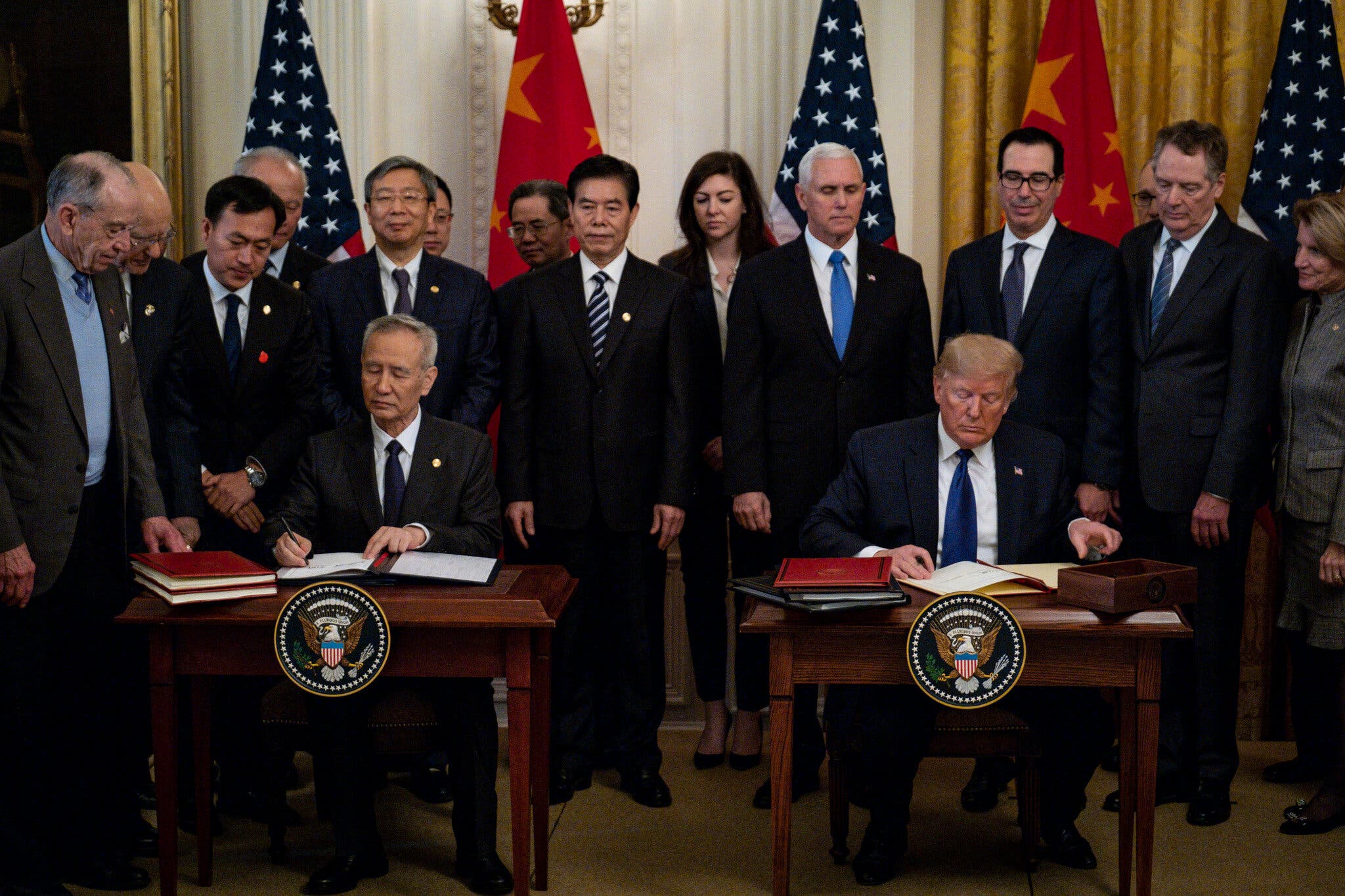Key Players In China's US Deal Negotiations

Table of Contents
Key Players on the Chinese Side
The Chinese side of US-China trade negotiations is characterized by a highly centralized decision-making structure, with the Chinese Communist Party (CCP) at the helm. Understanding this hierarchical structure is key to comprehending China's negotiating positions.
The Chinese Communist Party (CCP) Leadership
The CCP Politburo Standing Committee holds ultimate authority over all aspects of Chinese policy, including trade negotiations. The General Secretary, currently Xi Jinping, has the final say on all major decisions. This centralized power structure contrasts sharply with the more diffuse power structures often seen in Western democracies.
- The CCP Politburo Standing Committee: This powerful group sets the overall strategic direction for China's economic and foreign policy, providing the overarching framework for trade negotiations with the US.
- The Vice Premier for Economic Affairs: This individual plays a crucial hands-on role in formulating economic strategy and directly overseeing negotiations. They often lead the Chinese delegation in high-level trade talks.
- CCP Economic Priorities: Understanding the CCP's overarching goals—such as achieving technological self-reliance ("Made in China 2025"), securing domestic supply chains, and maintaining economic growth—is essential for interpreting China's negotiating positions. These priorities often influence the concessions China is willing to make.
Detailed Explanation: The CCP’s centralized decision-making process can lead to a more unified negotiating stance, but it can also limit flexibility and compromise. The emphasis on national interests and long-term strategic goals sometimes overshadows short-term economic considerations.
Ministry of Commerce (MOFCOM)
The Ministry of Commerce (MOFCOM) is the primary government agency responsible for the technical aspects of negotiating trade agreements with the US and other countries.
- MOFCOM's Role: MOFCOM handles the day-to-day details of negotiations, drawing up proposals, responding to counter-proposals, and coordinating with other government agencies.
- Key Negotiators: Senior officials and expert negotiators within MOFCOM lead the technical discussions, leveraging their expertise in international trade law and policy to advance China's interests.
- MOFCOM's Expertise: Their deep understanding of WTO rules and international trade practices is crucial in shaping China’s strategies and arguments during the negotiations.
Detailed Explanation: MOFCOM acts as the implementing arm of the CCP’s broader economic strategy, translating high-level political directives into concrete negotiation positions and actions. Their internal structure is highly organized, ensuring coordinated and consistent messaging.
State-Owned Enterprises (SOEs)
China's powerful State-Owned Enterprises (SOEs) play a significant, albeit often indirect, role in influencing China's negotiating stance in US-China trade talks.
- SOE Influence: Massive SOEs in sectors like technology (e.g., Huawei), finance (e.g., the major state banks), and manufacturing exert considerable influence on the government's policy decisions.
- Lobbying Efforts: These enterprises often lobby the government to protect their interests, which can significantly impact the Chinese government's negotiating strategy.
- SOE Vulnerability: The performance and vulnerabilities of SOEs directly influence the government's willingness to compromise in trade negotiations, as protecting these entities is often a key priority.
Detailed Explanation: The intertwined interests of SOEs and the Chinese government's national economic strategy cannot be ignored. The government's desire to protect and nurture these key enterprises shapes its approach to trade negotiations.
Key Players on the US Side
The US side of the negotiations involves a more complex interplay of powers, with the executive branch taking the lead but significant input from the legislative branch.
The White House and the President
The US President sets the overall tone and direction of US trade policy towards China. Their decisions significantly impact the entire negotiation process.
- Presidential Authority: The President holds ultimate authority in setting the overall negotiating goals and approving any final agreement.
- Key Advisors: The National Security Advisor and the US Trade Representative (USTR) play crucial roles in advising the President and shaping their approach to trade negotiations with China.
- Domestic Political Pressures: Domestic political considerations, including public opinion and lobbying efforts by different industries, exert considerable influence on the President’s approach.
Detailed Explanation: The President’s stance on trade with China often reflects their broader foreign policy goals and domestic political priorities. Public pressure and the need to secure congressional support can influence the administration's negotiating strategies.
The Office of the United States Trade Representative (USTR)
The USTR is the lead agency responsible for conducting trade negotiations on behalf of the US government.
- USTR's Role: The USTR's team of highly skilled negotiators engages in direct talks with their Chinese counterparts, working to achieve the administration’s trade objectives.
- Negotiating Expertise: The USTR boasts considerable expertise in international trade law, economics, and negotiation strategies.
- Legal Expertise: Their deep understanding of WTO rules and precedents is vital in crafting and defending US positions during negotiations.
Detailed Explanation: The USTR’s structure is designed for efficient and effective negotiation, coordinating with various government agencies and industry representatives to develop comprehensive strategies.
US Congress and Related Committees
The US Congress, particularly the Senate Finance Committee and the House Ways and Means Committee, plays a significant role in overseeing and shaping US trade policy with China.
- Congressional Oversight: These committees hold hearings, conduct investigations, and review trade agreements, providing crucial scrutiny of the executive branch's actions.
- Legislative Influence: Congress can pass legislation that impacts trade relations with China, either directly (through trade sanctions) or indirectly (by influencing budget allocations).
- Confirmation Power: The Senate's power to confirm the USTR and other key administration officials gives it significant influence over the selection of individuals leading the negotiations.
Detailed Explanation: Congressional support is crucial for the success of any trade agreement with China. Lack of support can lead to legislative hurdles, potentially jeopardizing the negotiation's outcome.
Understanding the Dynamics of the Negotiations
The US-China trade relationship is incredibly complex, characterized by a delicate balance of power and competing interests.
- Power Dynamics: The negotiation dynamic is shaped by the vastly different political and economic systems of the two countries, resulting in contrasting negotiation styles and approaches.
- Domestic Political Pressures: Both sides face domestic political pressures that can impact their negotiating strategies and willingness to compromise.
- Global Economic Conditions: Shifting global economic conditions, such as pandemics or technological disruptions, can significantly influence the context and outcomes of negotiations.
Detailed Explanation: The interactions between these players are dynamic and constantly evolving, influenced by a complex mix of political, economic, and geopolitical factors. Successfully navigating this complex landscape requires a deep understanding of each actor's motivations and constraints.
Conclusion
Understanding the key players in China's US deal negotiations is crucial for comprehending the complexities and potential outcomes of these critical discussions. From the CCP leadership and MOFCOM on the Chinese side to the US President, USTR, and Congress, these actors shape the direction of trade policy and the future of the US-China economic relationship. By analyzing the roles and motivations of these key players, we can better understand the challenges and opportunities involved in navigating this intricate relationship. To stay informed about the latest developments and the evolving roles of these key players, continue to follow updates on US-China trade negotiations and delve deeper into the strategies employed by each side. Keep informed on the actions of these key players to better understand the future of China's US deal negotiations and the broader implications for global trade.

Featured Posts
-
 Tarim Kredi Koop 2 4 Mayis 2025 Temel Gida Ve Temizlik Ueruenlerinde Indirim Firsatlari
May 15, 2025
Tarim Kredi Koop 2 4 Mayis 2025 Temel Gida Ve Temizlik Ueruenlerinde Indirim Firsatlari
May 15, 2025 -
 First Up Daily News Key Updates From Bangladesh China And The Caribbean
May 15, 2025
First Up Daily News Key Updates From Bangladesh China And The Caribbean
May 15, 2025 -
 R5 45 Crore Penalty On Paytm Payments Bank Fiu Inds Action On Money Laundering
May 15, 2025
R5 45 Crore Penalty On Paytm Payments Bank Fiu Inds Action On Money Laundering
May 15, 2025 -
 Dodgers Quiet Bats Lead To Defeat Against Cubs
May 15, 2025
Dodgers Quiet Bats Lead To Defeat Against Cubs
May 15, 2025 -
 Experience Chocolate Heaven At Lindts New Central London Store
May 15, 2025
Experience Chocolate Heaven At Lindts New Central London Store
May 15, 2025
